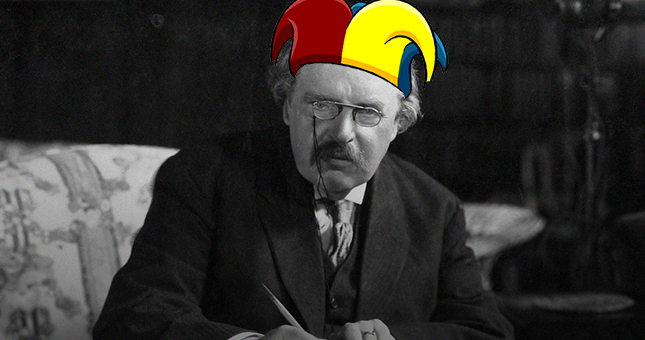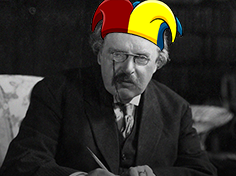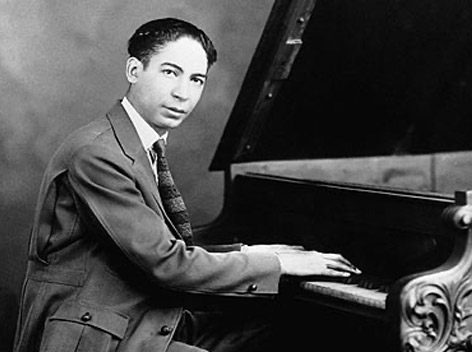
GK Chesterton on the Fool as Saviour of the Modern Soul
Holy foolery wasn’t just a theological theme for the great British Catholic; he reveled in becoming the fool.
The 1928 entry on humour in Encyclopedia Britannica reads nothing like a typical encyclopedic entry. It has willy-nilly statements and inaccuracies and opinions with neither support nor explanation; though avoiding a typical encyclopedic definition, the entry does get at the pathos of humour profoundly, and when the reader gets to the last summarizing sentence of the entry, there is a punchline:
Humour, like wit, is related however indirectly, to truth and the eternal virtues; as it is the greatest incongruity of all to be serious about humour, so it is the worst sort of pomposity to be monotonously proud of humour; for it is itself the chief antidote to pride; and has been, ever since the time of the Book of Proverbs, the hammer of fools.[1]
The author of this encyclopedia entry was Gilbert Keith Chesterton (1874-1936). He joked and entertained at unexpected times, as in the aforementioned narrow assignment of defining a word for an encyclopedia entry. Chesterton continues to be one of the most quoted writers of the 20th century—mostly because he was hilarious! He was loved by secular England, in spite of being an unashamed Christian intellectual, because he was willing to play the part of the fool. (In fact, one of his “frenemies”, with whom he regularly sparred, George Bernard Shaw, referred to him as a “colossal genius”.) He spent his life and writing joking, poking fun, reveling in the absurd, the nonsensical, the paradoxical—in so doing exposing the spiritual, intellectual, and political fallacies of Edwardian England and modernity more broadly—and humour, as the hammer of the fools, was the polemical tool he most often employed. It was more than a tool, though, it was a chosen and intentional way-of-being.
When writing as a lay theologian, humour, play, laughter, and folly were central to his thoughts on God; that he had a common theme of “lunacy”—cast in a positive way in “good men”—is evident in much of his fiction; that he loved the crazy, foolish wisdom of St. Francis of Assisi has been established in his enduring hagiography of that saint. He didn’t just think the humour of the fool was funny entertainment, he came to see the vision of the fool[2] as the prophetic way, the way of embracing the foolishness of Christ (1 Cor. 4:10), the way that could break man, Church, and society out of the prison of disenchanted modernity.
Living Life as a Fool
Chesterton shares many characteristics with great holy fools in history: He shares their child-likeness, willingness to embrace humiliation, political acuity, love of pranks, questioning of the status quo—and, ultimately, their Christ-likeness. Consider Michael Asquith’s reflection of a time when Chesterton’s obesity resulted in him being stuck in a door:
Chesterton was the only man I have ever seen stuck in a door. It was entirely typical of him that he seemed greatly to enjoy this experience. I think this was perhaps another reason for his great popularity with children—his willingness to make himself ridiculous in public. ‘Willingness’ is really too weak a word. He positively delighted in it. He was in fact so far the reverse of pompous that you might almost say he was always standing on his indignity. Others might proclaim their triumphs and recite their success stories; it was in his failures and fiascoes that GKC preferred to glory… A jester of genius he certainly was. But … he was first and foremost a prophet. The cap and bells were only a means to capture an audience. This done, they were thrown aside, and the jester got down to his real business, which was not entertainment but salvation.[3]
There is nothing respectable about a person being stuck in a doorway, but Chesterton, as fool, was free from the trappings of respectability. He truly lived his inspired fooling out in his day to day life, aptly summarized, perhaps, in Heretics (1905): “A man who has faith must be prepared not only to be a martyr, but to be a fool. It is absurd to say that a man is ready to toil and die for his convictions when he is not even ready to wear a wreath round his head for them.”[4] His choice of living as a fool for Christ was made explicit in Orthodoxy (1908), the story of his unlikely journey to Christianity: “No one can think my case more ludicrous than I think it myself; no reader can accuse me here of trying to make a fool of him: I am the fool of this story, and no rebel shall hurl me from my throne.”[5]
Chesterton’s Collection of Fictional Fools
In Chesterton’s fiction, often the protagonist is a fool and stranger: He doesn’t belong to this world, is a wanderer, a prophet sent from another world to deliver modern man from his prison of thought who finds himself in a strange (modern) world and out of place. Consequently, Chesterton’s fools get labeled as lunatics by the “normal” (secular, modern, liberal, “free thinkers”) characters; the madness of the “normal” world, which claims to be sane, is contrasted with the “insanity” of a character whom the “normal” world thinks “mad.” In the end, the reader comes to see the “upside down” fool as the only truly “sane” character. Examples of this stock character can be seen in: Gabriel Gale in The Poet and the Lunatics, Adam Wayne in The Napoleon of Notting Hill, Syme in The Man Who Was Thursday, Herne in The Return of Don Quixote, Mr. Pond in The Paradoxes of Mr. Pond, and Innocent Smith in Manalive.
In the case of Manalive, the holy fool, Innocent Smith, as a fresh wind, is blown into the small world of a rooming house and immediately begins making a hilarious slapstick mess of things. After several shenanigans, he is quickly put on trial for polygamy, burglary, and attempted murder, all grave misunderstandings, as far as Innocent is concerned. Near the end of the novel, Michael Moon gives a defense of the acquitted Innocent, who, we are told: “lashed his soul with laughter to prevent it falling asleep.”[6] In so doing, we see how the Chestertonian fool breaks conventions, using pranks and humour to shock people into seeing and experiencing the truth of their own lives. This is Chesterton’s portrait of the fool in Manalive:
His principle can be quite simply stated: he refuses to die while he is still alive. He seeks to remind himself, by every electric shock to the intellect, that he is still a man alive, walking on two legs about the world. For this reason he fires bullets at his best friends; for this reason he arranges ladders and collapsible chimneys to steal his own property; for this reason he goes plodding around a whole planet to get back to his own home; and for this reason he has been in the habit of taking the woman whom he loved with a permanent loyalty, and leaving her about (so to speak) at schools, boarding houses and places of business, so that he might recover her again and again with a raid and a romantic elopement... The idea that Smith is attacking is this. Living in an entangled civilization, we have come to think certain things wrong which are not wrong at all. We have come to think outbreak and exuberance, banging and barging, rotting and wrecking, wrong. In themselves they are not merely pardonable; they are unimpeachable. There is nothing wicked about firing off a pistol even at a friend, so long as you do not mean to hit him and know you won’t… This man’s spiritual power has been precisely this, that he had distinguished between custom and creed. He has broken the conventions, but he has kept the commandments.[7]
The Chestertonian fool, then, is a type of living parable, who, by getting us laughing, ushers forth new eschatological worlds and possibilities, saving us from the malaise of conventional thought and practice.
St. Francis the Holy Fool
Soon after Chesterton’s conversion to Catholicism, Chesterton published, essentially, another riff on the holy fool in St. Francis of Assisi (1923). The story of St. Francis was an important one in Chesterton’s childhood and development. In his Unitarian household, the myth of St. Francis was read to him, and he fell in love with St. Francis long before he ever converted to Christianity as an adult. In this way, the story of the St. Francis of his youth served as a connecting pin to his later faith. The saint’s life becomes a sort of hermeneutical key for Chesterton to understand the good news of the gospel of grace, and how grace works itself out in the world. When he writes his chapter on St. Francis as Jongleur de Dieu, this is perhaps closest to how Chesterton understood Francis’s, and his own, vocation as troubadour-like entertainer, as a juggler for God. Decades before Chesterton would publish his hagiography of the saint, he wrote of the conundrum the entertaining and happy medieval Francis would have posed toward modern people:
To most people, however, there is a fascinating inconsistency in the position of St. Francis. He expressed in loftier and bolder language than any earthly thinker the connection that laughter is divine as tears. He called his monks the mountebanks of God. He never forgot to take pleasure in a bird as it flashed past him, or a drop of water as it fell from his finger; he was, perhaps, the happiest of the sons of men.[8]
The enigmatic figure of Francis can only be understood by what Chesterton interprets as his radical conversion to holy folly. In Chesterton’s telling, early in St. Francis's life, after much prayer in a cave, Francis emerges from the cave and sees the world differently, sees the world upside down. He has a breakthrough. After much desperation and humiliation in his prior life, Francis has a final spiritual, paradoxical overturn in which complete humiliation becomes complete happiness. In the cave, Francis goes through a paradigm shift where he begins to embrace the “fool’s paradigm” as the way to think and be.[9] He writes: “As he stared at the word ‘fool’ written in luminous letters before him, the word itself began to shine and change.”[10] This is Francis in his true calling and self understanding. Chesterton continues, “...when Francis came forth from his cave of vision, he was wearing the same word ‘fool’ as a feather in his cap; as a crest or even a crown. He would go on being a fool: he would become more and more of a fool; he would be the court fool of the King of Paradise.”[11]
The Fool for Today
Humour, joking, and laughing, rather than logical discourse, is often the best way we can know God and experience embodied truth and healing.[12] Put another way, from the man who was once stuck in a door: “Humour can get in under the door while seriousness is still fumbling at the handle.” For while it is helpful to understand ourselves as man the thinker (homo sapiens), or man the tool user (homo faber), it is also instructive to remember that we are, uniquely, man who laughs and plays (homo ludens). No other animal laughs but us. Indeed, to borrow a favourite word from Regent College Professor Emeritus Dr. Loren Wilkinson, we may know our creatureliness most profoundly in relation to our creator God when we are laughing! It is in our embrace and participation with the joking, dancing and laughing fool that we can find genuine liberation as creatures whose identity and purpose rest in the self-emptying love of the confounding, laughing, and scandalous God. The holy fool scandalizes, is an affront to the rationalization and commodification of life, he acts Christ out in a given community, dismantling preconceived religious systems of moralism and rationalism. Christ the fool is scandal.[13] He acts out against respectable cultural practice and “required” religious behaviour in his everyday life: when he responds to “gotcha” questions from the religious elite with riddles, when he generates vast amounts of wine at a wedding, when he parties with the disreputable, and when he speaks forgiveness to those perceived outside the bounds of divine acceptance.
Chesterton the fool, dressed in ridiculous everyday outfit of crumpled hat, cape, and sword stick—with pince-nez and cigar firmly scrunched into his face—stands as an unlikely, ludicrous, and prophetic figure at a time such as ours where a disenchanted modernity and secularization has pushed religious thought and practice further into the margins of public life—in a time such as ours in desperate need of Church renewal. In an article titled “Revive the Court Jester” Chesterton lamented this strange and reductive world he saw on the horizon. But he did not despair for he had belief in one who could still reach us: “We shall have no Priest, for we have no religion. The best we can deserve or expect is a fool who shall be free, and who shall deliver us with laughter.”[14]
Looking for more foolery? Head over to the "Theological Comedy Awards." Contestants include Thomas Aquinas's joke article, Martin Luther's elaborate prank, and the great Lady Pope hoax.
[1]Encyclopaedia Britannica, 1929.
[2]This is the title of the riveting essay by 20th Century British artist, Cecil Collins. See Kirstin Jeffrey Johnson’s (MCS 1999, Regent World author of: “How to Start a Local Reformation”) excellent introduction to Collins’ work.
[3]Michael Asquith. “G.K. Chesterton: Prophet and Jester”, The Listener, March 6,1952, G.K. Chesterton: A Half Century of Views (New York: Oxford University Press, 1987), 120, 122.
[4] Heretics. The Collected Works of G.K Chesterton, Ignatius Press, San Francisco, 1986, p. 87.
[5]Orthodoxy. New York: Lane, 1909.
[6]Manalive, London: Thomas Nelson, 1912.
[7]Ibid., 368–369.
[8]“The Speaker”, Reprinted in 12 Types (London: Arthur L. Humphreys, 1910), 74–75.
[9]Chesterton’s telling of this conversion is directly alluded to in Mumford and Sons hit song “The Cave” from Sigh No More, 2010.
[10]St Francis of Assisi. Image, Double Day, New York: 1990, p 69.
[11]Ibid. p.70.
[12]Notice that tens of thousands of people from around the world have travelled to Toronto and the Toronto Airport Vineyard Church since the mid 1990s, not to hear rational arguments, for example, of Anselm’s ontological argument for the existence of God, but rather, simply, to laugh.
[13]Consider this insight from Harvey Cox: “Like the jester, Christ defies custom and scorns crowned heads. Like a wandering troubadour he has no place to lay his head. Like the clown in the circus parade, he satirizes existing authority by riding into town replete with regal pageantry when he has no earthly power. Like a minstrel he frequents dinners and parties. At the end he is costumed by his enemies in a mocking caricature of royal paraphernalia. He is crucified amidst sniggers and taunts with a sign over his head that lampoons his laughable claim.” Feast of Fools, (Harper and Row, New York, 1969), p. 140–141.
[14]Revive the Court Jester in The Collected Works of G.K. Chesterton: Vol V, (San Francisco: Ignatius Press, 1986).



